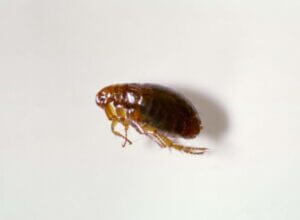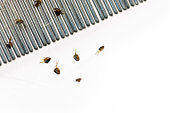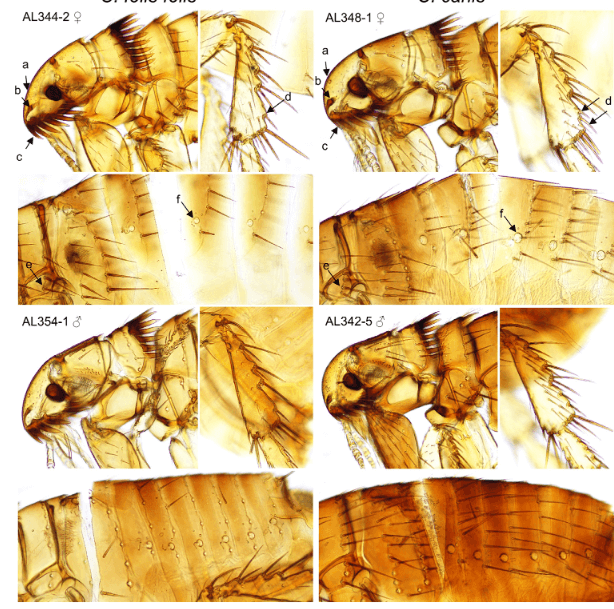
THE WORLD OF DOG FLEAS
FLEA DESCRIPTION AND CHARACTERISTICS

Length: the adult flea is approximately 2.5 mm long
Color: the color is dark, ranging from brown to reddish-brown
Body: it is thin and flat with hair
Mouths: the adult flea has parts of the mouth that are used to extract blood from the host
Legs: there are six long legs
Wings: fleas don’t have wings
Jumping: fleas are noted for jumping great distances relative to their size, from host to host
As many of us already know, fleas are hard to kill by hand and usually require chemical treatment.
A fleas body is thin and flat, allowing for easy movement through an animal’s fur. Their bodies are also covered in hair that serves to root them to the animal.
Fleas are commonly seen moving in an infected pet’s fur. Their presence may be marked by reddened skin.
FLEAS, MORE THAN A NUISANCE
More than just a pest, fleas can lead to health risks to dogs and other animals including people. The danger is because these tiny external parasites feed on the blood of animals and us. To protect your dog, there are some basics you should know about in the risks, prevention, and treatment of fleas. Armed with this knowledge, you will help protect your dog and home from fleas.
While there are several types of fleas, the one the most commonly affects dogs, cats, and other house pets in North America is the cat flea ( Ctenocephalides felis ). While this type of flea can and will bite people, humans are not the best host. This flea prefers cats, dogs, rabbits, rodents, and smaller mammals.
A FLEA’S LIFECYCLE
THE FOUR STAGES
Egg: The adult female flea can lay up to 40 eggs a day ( 20-30 is the most common ). The eggs are laid on the host but will quickly fall off that host ( dog ) into the environment. They land on pet bedding, carpets, wood floors, upholstery, etc. Within the home, eggs typically hatch within two to three days.
Larva: When the eggs hatch, the larvae emerge. These tiny worm-like creatures feed primarily upon flea feces in the environment ( this is in reality dried blood ) and unhatched eggs. The larva then goes through three stages of growth before it spins a cocoon and enters the pupal stage. The larval stage typically lasts from 5 to 15 days under the conditions found within most homes.
Pupa: Within its cocoon, the pupa begins its transformation into an adult flea. The cocoons are almost indestructible and attract dirt and debris that camouflage them. Pupae can remain dormant in the environment for many months. Fleas in the pupa stage will generally not emerge until they sense a host. They use factors like warmth and pressure to sense a host.
Adult fleas: The newly-emerged flea jumps on the host and begins feeding on the blood as quickly as possible. A female flea will usually begin to lay eggs within two days of its first meal of blood. She defecates blood from her host that will fall off the host along with the eggs, restarting the life cycle. Adult fleas typically live for about a week or two on pets but can survive much longer under ideal, artificial conditions.
Now you know why some dogs get infested with fleas soon after moving into a new home or visiting a new place that has been free of pets for a few months. The pupae emerge as soon as they find a dog or pet. One dog can suddenly have hundreds of fleas that seem to come out of nowhere. Just within a couple of days, the fleas are reproducing all over the place and seem out of control.
FLEAS CAN BE DANGEROUS
Fleas are not just annoying but can also present a health risk to your pets such as:
- Flea allergic dermatitis: Itching from fleas is caused by a localized allergic reaction to flea saliva. Some animals are more sensitive than others, flea bites can lead to severe itching, irritation, scratching, skin damage, and major skin infections in some pets. Then there are the pets that seem to not react at all to the fleas because they do not have the same allergic reactions.
- Anemia: If enough fleas infest the dog, the host animal can lose enough blood to become anemic. Small puppies and ill weak dogs are especially at risk. If not caught soon enough, a dog can die or suffer medical complications as a result of anemia.
- Tapeworm infection ( Dipylidiym caninum ): This type of tapeworm can be contracted after the accidental ingestion of an infected flea ( during self-grooming, for example ). Flea larvae often ingest the microscopic tapeworm eggs, causing adult fleas to be carriers.
FLEAS SPREAD DISEASE
THE SPREADING OF TYPHUS, PLAGUE, AND BARTONELLOSIS
Save your dog from fleas by preventing a flea infestation in the first place. Always check your dog for fleas periodically and give flea prevention to your dog all year round. Keep fleas from disrupting your life and the lives of your pets and your family with this newly learned knowledge. If you suspect your pet is under attack from these fleas call your vet immediately. For health-related questions, always consult your veterinarian, as they have examined your pet before and know it’s health history, and can make the best recommendations for your dog.

HOW TO LOOK FOR FLEAS ON YOUR DOG
Unfortunately, dogs who aren’t allergic to flea saliva don’t always scratch when they have fleas. To complicate matters more fleas are wily and great at hiding. So what can you do to determine if it’s fleas or something else your dog has.
WHERE DO FLEAS LIKE TO GATHER ON THE DOG
The most common congregating area for fleas is around the base of your dog’s tail and lower back. You can find them anywhere on your dog’s body but if there are only a few fleas and want the best chance of finding them, start there.
PUSH THE FUR BACKWARDS TO SEE BETTER
Fleas don’t waste much time on the top of your dog’s fur. That’s not where their lifeblood ( food ) is. They need to get down to your dog’s skin in order to sink their mouthparts into their host and drink the blood. The best way for you to see your dog’s skin is to gently push the fur backward with your hand.
DON’T EXPECT TO SEE THE ACTUAL FLEA
A dog’s flea is sneaky and there isn’t always a lot of them on your pet at a given time. You’ll have to look for more evidence than just live fleas. The other signs that fleas indeed are eating on your dog is their excrement. They leave flea feces wherever they go:
- Flea stool impersonates small specks of black dirt and is called “flea dirt.”
- Look for and collect any dirt that you find during your flea hunt and also when you search with a flea comb.
- When you take some of the dirt look-a-likes, place them on a white paper towel, sprinkle water on them, and give them a little rub, you’ll see red smudges appear. This is a definite answer for you that your dog has fleas. The reason the flea dirt turns red is that it is just digested blood.
USE A FLEA COMB
If you haven’t spotted fleas or flea dirt at this point, go purchase a flea comb and then run it all over your dog, stopping every swipe or two to examine what the comb has come up with. Look for fleas and flea dirt. Fleas can slip through the bristles of a regular comb, but a flea comb’s tines are too close together for the fleas to squeeze between. You can catch them this way, but be ready to put them in some soapy water or squish them really hard, they are expert escape artists and their exoskeletons are hard to crush.
WHAT’S THE NEXT STEP WHEN FLEAS ARE FOUND
WASH THEIR BEDDING
Don’t neglect cleaning where your dog sleeps. By keeping their bedding clean you can help to reduce many of the issues associated with these pests. If your dog has fleas, take all of the bedding and put it into the washing machine on the deep cleaning cycle. Hot water will kill the fleas. If some happen to survive the hot water, throw away the bedding, and buy brand new ones. It’s also important to wash all the bedding in your home and sterilize the couches too since pets often sleep on them.
GIVE THE DOG A BATH
From experience only use flea shampoo’s when absolutely necessary because they can dry your dog’s skin. When used, use a professional flea shampoo for a good bath. The flea shampoo contains natural flea irritants that will cause them to get off your pet’s fur. Wash your dog for at least 15 minutes to give the shampoo enough time to really drown the fleas. After they are clean, spray a little tea tree oil on their coat to deter other fleas. Again use only when really necessary, a flea collar on them will also help get rid of the fleas.
Start the bath from their neck so you can keep the fleas from jumping and getting on the dog’s head. Wear a hair cap because the fleas will search for a new host and they will jump on to humans. Use a flea comb after you wash the dog to search for other fleas.
IF YOUR FLEA PROBLEM IS SEVERE USE BORATE ACID
Adult fleas can live 7 days without having blood to feed on from their host but their larvae can live longer. You need to make sure you are able to sterilize the entire home to kill the larvae. Borate acid can do a great job of killing the larvae and other fleas that may be lingering in your home. The best way to truly sterilize the home with borate acid is to pour it all over including corners, under furniture, and any dark areas, then leave your home for at least 24 hours. This will give it enough time to really destroy the fleas. Then you can vacuum and clean up your home so you do not have the powder all over the place. Look for sprays that contain IGRs because this poison will kill the larvaie and the fleas.
WHAT DOES A FLEA BITE LOOK LIKE ON A HUMAN
FLEA BITE APPEARANCE
Flea bites result in red spots surrounded by reddened haloes. They are extremely itchy and cause a lot of irritation. Fleas like to target the legs and feet of humans and sad to say I once had a flea get in my hair. Don’t forget that many wildlife species can carry fleas as well and can spread fleas to you and your dog if you come in contact with them. Flea saliva can cause increased scratching resulting in hair loss and secondary infections. In more severe cases, the affected pet skin thickens and sores appear.
A note: cold water alleviates inflammation and warm and hot water exacerbates itching.
WHAT TO DO IF YOU GET FLEA BITES
- Wash the bite
- use an antiseptic and apply an icepack
- try to resist scratching
- lotions may be used to treat the itch
- consult a pharmacist about antihistamines
Should the bite wound excrete puss, contact your doctor immediately. Treating flea bites merely addresses one symptom of an infestation. Extermination methods should be conducted in conjunction with bite treatments in order to ensure eradication.
USING FLEA BOMBS, TRAPS AND SPRAYS
WHAT ARE THE PROS. & CONS OF DIY FLEA CONTROL METHODS & PRODUCTS
FLEA BOMBS
Flea bombs treat indoor flea infestations through the indirect application of chemicals. The bombs are designed to be left alone to release pesticides into the room and kill the fleas.
Sounding like the perfect solution to indoor flea infestations, their chemicals often do not reach hidden or sheltered areas, such as the spaces beneath furniture or the interiors of closets and cabinets. These spaces can become a refuge for the fleas. When fleas are in these protected areas they will be unaffected by the flea bomb and therefore not controlled. Flea bombs also do not address outdoor infestation or animal infestation. One of the most critical parts of a successful flea control program is addressing the source of the fleas. Dogs and pets should be treated with the appropriately labeled product homeowners can purchase from their veterinarian. When the pet is the source and not treated, it will lead to a continuation of flea activity and likely failure of the other treatments. The areas outside where the animals and wildlife reside also need to be treated, or else the homeowner may pick up fleas when outside the home.
Flea bombs also leave behind a residue on surfaces and can contaminate exposed food and food preparatory surfaces. Finally, certain stages of the flea’s life cycle are not likely to be affected. Pupae and adults inside the cocoons are not as affected as they are in other stages. For these reasons, a flea bomb is not considered an effective or recommended solution. Contact your local pest control professionals for effective, customized pest control options.
THE PROBLEMS WITH FLEA TRAPS AND SPRAY PRODUCTS
Flea traps do capture some fleas, but the trap’s greatest value is as a monitoring tool, not a control tool. Traps only catch adult fleas and have very little impact on their eggs, larval and pupal flea stages. Flea traps do make good monitoring devices and can serve as a warning device to let a property owner know a flea problem could be soon coming.
FLEA SPRAYS
While consumer spray products will kill fleas, a homeowner should never rely solely on sprays. A flea aerosol bomb may seem like a good control product for indoor flea problems, but may not reach into the sheltered areas around the home where flea larvae and pupae are living. Therefore, areas like inside closets, cabinets, under furniture, and on pets may become a refuge for the fleas that survive the flea bombs. Also, consumer spray products are usually not as long-lasting as those products used by pest management professionals.
Flea control should never rely solely on sprays since effective flea control depends on using an integrated, multifaceted range of control techniques and products such as:
- Using insect growth regulators that interfere with the normal development of fleas from egg to adult stage.
- Conducting a thorough inspection to locate and identify flea sources both inside and outside the home.
- Using vacuums to physically remove all flea stages from carpets, furniture, and in the pet bedding areas.
- Using carpet cleaning equipment and frequently washing and drying pet bedding to kill the fleas.
- Educating the homeowner about flea habits, behavior, and habitats.
- Recommending that property owners consult with their pet’s veterinarian for advice regarding pet-related products and how to properly bathe and groom your dog/pets.
CONDITIONS CAUSED BY FLEA INFESTATION IN DOGS
- Anemia can be caused by severe flea infestation. Anemia is a condition caused by not having enough red blood cells to carry oxygen to all the body’s tissues. This is the result of fleas feeding on the host’s blood. It can cause death, especially in very small, young, or debilitated dogs.
- Flea allergy dermatitis is a skin condition that occurs when a dog is allergic to flea saliva. This condition causes intense scratching and can lead to hair loss and skin infections.
- Tapeworm infection with dipylidium caninum can be transmitted to dogs when they ingest fleas during self-grooming. While not harmful to the dog most of the time, it is not a pleasant condition for owners, as tapeworm segments will drop out of the dog’s rectum onto his bedding or floor-covering.
THE ACTUAL STEPS OF A FLEA’S LIFE CYCLE
KNOWING THESE STEPS WILL HELP IN THE FIGHT AGAINST FLEA INFESTATION
- Eggs: Eggs are laid on the dog by the adult flea. The eggs will fall off into the environment where they incubate in the carpet, the pet’s bedding, your bedding, the furniture, or the yard.
- Larvae: The flea eggs hatch to reveal small, crawling larvae. The food source for the larvae is the stool of adult fleas, which has also fallen off the dog. The larvae go through three molts, then they spin a cocoon and become pupae.
- Pupae: Inside the cocoon, the pupae develop into adult fleas. At this stage, they are very hard to kill. Pupae can stay dormant inside the cocoon for up to a year. They don’t emerge until they sense a host such as your dog nearby that can serve as a food source. They perceive this through vibrations, sound, light, and carbon dioxide variations.
- Adult fleas: Adult fleas aggressively search for a host in order to take their first meal of blood. Once she has fed, the female flea will begin to lay eggs within two days, and she will lay eggs until she dies. Fleas can live for four to six weeks, but they are often groomed off the host dog before that.
FLEA CONTROL PRODUCTS FOR DOGS
THESE ARE THE MOST COMMON PRODUCTS
- LUFENURON is a chemical that sterilizes female fleas when they bite a treated dog. These monthly pills should be given with a full meal. These products do not kill adult fleas. For this reason, used alone, they are not effective treatments for dogs with flea allergy dermatitis. However, used together with a product that kills adult fleas, they can be very effective in decreasing the general flea population in your home. Products containing lufenuron include:
- Program(R) is a flea sterilization product alone. Another product that controls adult fleas will be necessary with flea allergy dermatitis.
- Sentinel(R) contains lufenuron for flea sterilization, milbemycin oxime for heartworm prevention, and praziquantel for the control of some intestinal parasites. This product also contains no adult flea control, so allergic dogs may need an additional product.
- Imidacloprid is a chemical that is a very effective adult flea killer. It is found in the Advantage line of products as follows:
- Advantage®ll: This spot-on product is imidacloprid with the addition of pyriproxyfen, which expands its kill range to all the flea life cycles Advantage®ll is also waterproof.
- K9 Advantage®ll: This is a spot-on product that is imidacloprid, permethrin, and pyriproxyfen. It is labeled for use in killing all stages of the flea life cycle, as well as ticks. It also repels and kills mosquitoes as well as chewing lice and biting fleas. K9 Advantix®ll is ONLY for use in dogs, Death is possible if it is used on or in the vicinity of Cats.
- Seresto is a flea and tick collar that contains imidacloprid and the chemical flumethrin. It kills adult fleas and repels and kills ticks. The collar has a sustained release mechanism that allows the chemicals to spread from the site of contact with the collar over the rest of the dog’s skin. The collar will work up to eight months.
- Imidacloprid also comes in a wide range of Advantage® products for killing fleas, such as shampoos, direct sprays for the dog, carpet spray, yard spray, and a household fogger.
Fipronil is a chemical that kills adult fleas and ticks. It is found in Frontline® products.
- Frontline® Plus contains fipronil to kill fleas and ticks and (S)-methoprene to kill flea eggs and larvae. It is a spot-on product that controls fleas and ticks for around thirty days. It is also waterproof.
- Frontline®Tritak contains fipronil and cyphenothrin for killing adult fleas very quickly. It also contains (S)-methoprene killing flea eggs and larvae.
- Frontline® Spray is a product that can be applied directly to your dog, so it can start working immediately.
Selamectin is the chemical in Capstar®
- Revolution® is a spot-on product that kills adult fleas, sterilizes female fleas, prevents heartworm, and kills ticks, ear mites, and scabies.
Nitenpyrim is the chemical in Capstar®
- Capstar® is an oral tablet that kills the fleas that are on your dog, usually within 30 to 60 minutes. It can be repeated up to once a day as needed. Capstar® can be useful if your dog has been at a kennel or another environment with fleas and you would like to remove the fleas before you take your dog home. It can also help give relief to the allergic dog while you wait for another product to begin working.
Spinosad® is a new class of chemicals, present in Comfortis® products, which come in the form of monthly oral tablets.
- Comfortis® kills adult fleas very fast, so it is useful for flea allergic dogs.
- Trifexis® contains spinosad to kill adult fleas and milbemycin oxime for heartworm preventative.
Dinotefuran is a fast-acting adult flea killer, present in Vectra® products
- Vectra 3-D for dogs contains dinotefuran to kill fleas quickly. It is helpful in flea allergic dogs. It also contains permethrin to kill and repel ticks and mosquitoes. The third ingredient is pyriproxifen, an insect growth inhibitor to control the egg stage. This product should never be used on or in the vicinity of cats, it could cause death.
Fluralaner is a chemical that kills adult fleas and three common types of ticks.
- Bravecto® contains fluralaner, and is given as a chewable tablet every twelve weeks.
Afoxolaner is a chemical that is given to dogs orally to kill fleas and ticks.
- Nexgard® contains afoxolaner and is given to dogs as a monthly chewable tablet.
This is only a partial list of products. Your veterinarian can help you choose the product or combination of products that best suits your dog’s lifestyle and situation.
FLEAS CAN BUILD UP A RESISTANCE TO THESE PRODUCTS
Flea populations may be seen to develop some resistance to a product over time. While this has not been seen in the widespread flea population, it may develop on a small scale such as in your home. Your veterinarian may recommend that you alternate the product that you use periodically. This will make it harder for the flea population to develop resistance to any single product.
IN CONCLUSION
FLEA INFESTATION
The best medicine is prevention, but if you already have a flea infestation in your home, these products can help you control and eliminate it. You may also need to use a product that treats your home and/or yard. Your veterinarian can help you determine the product or product combination that will help you get rid of the fleas in the fastest way. It is important to stick with the treatment. It may take several months to break the flea life cycle, and you may continue to see some fleas during that period.


